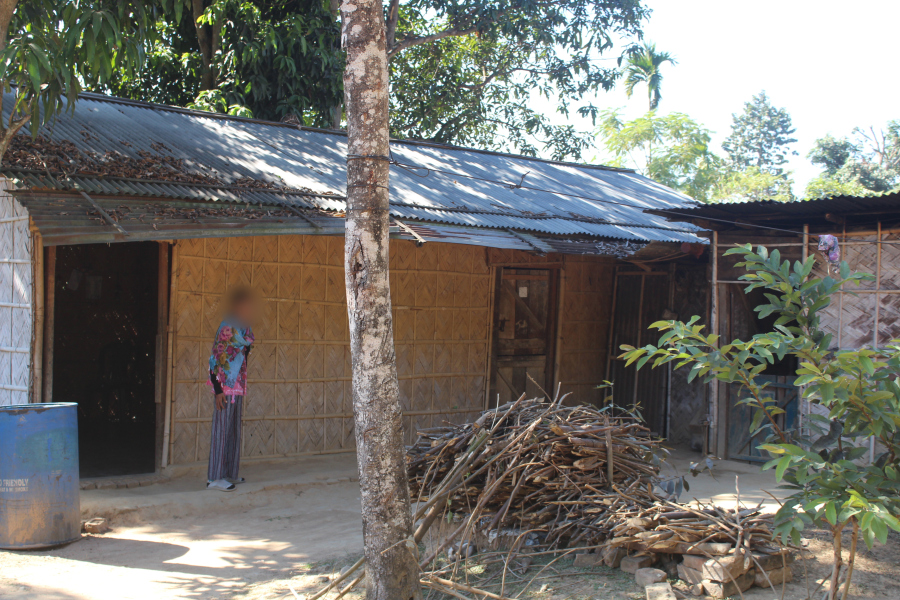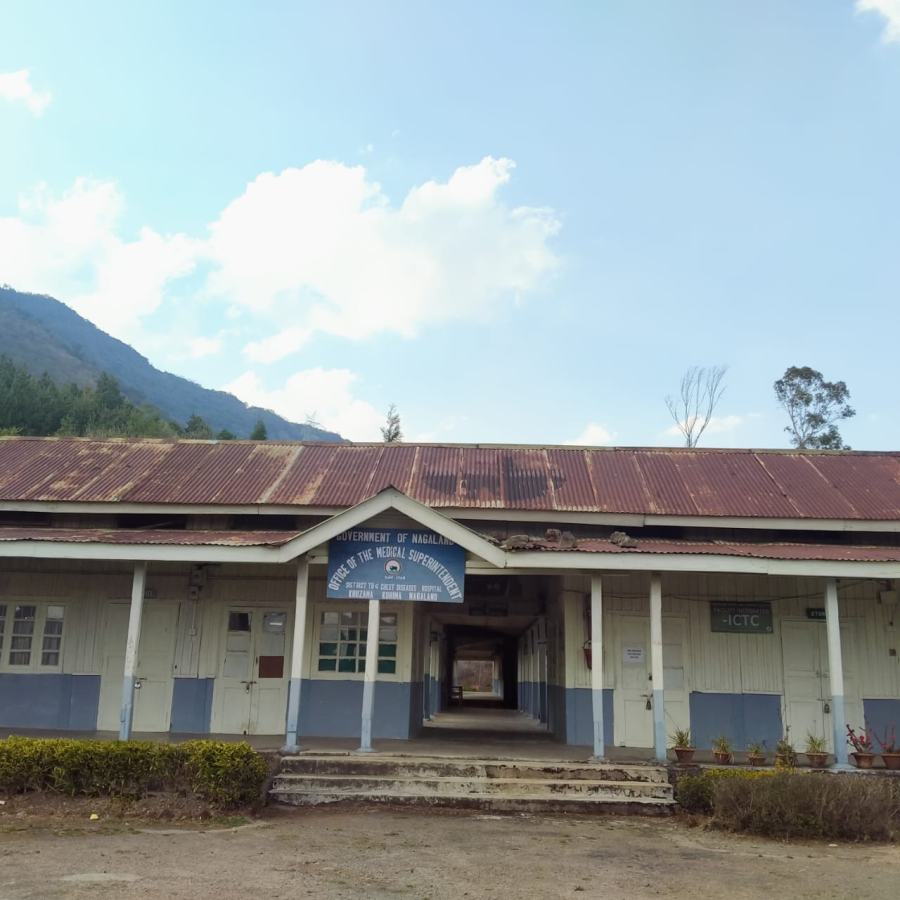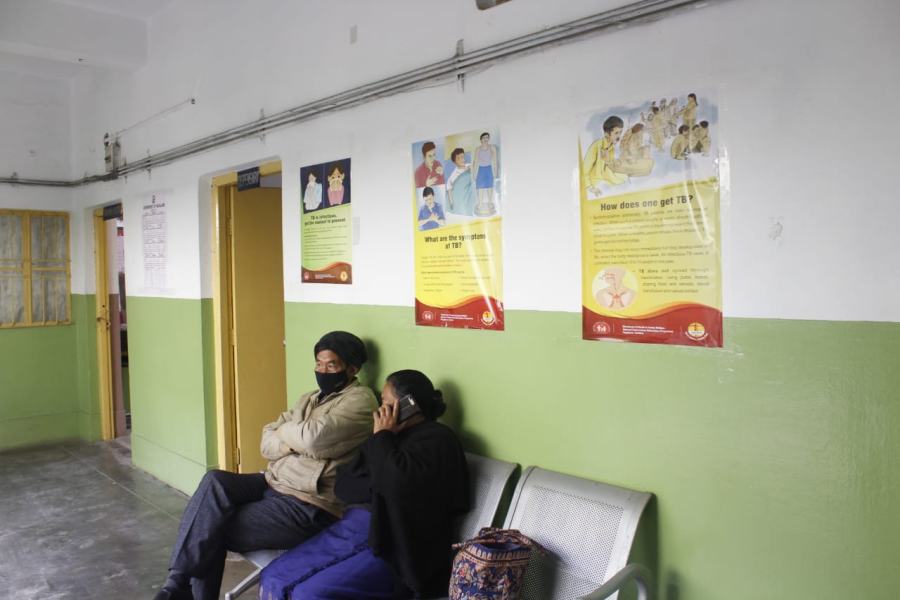1. A man seen holding a drug regimen used for treatment of tuberculosis, specifically, multi-drug-resistant tuberculosis (bedaquiline) along with other medications for tuberculosis.
 An MDR TB recovered woman seen outside her home.
An MDR TB recovered woman seen outside her home.

An outside view of the District TB & Chest Diseases Hospital at Khuzama Village under Kohima District. It is among the only two TB Hospitals in Nagaland.

Out patients outside the District TB Centre in Kohima.
Ketholeno Neihu
Kohima | February 14
In the distant Indo-Myanmar border village of Longwa, Ngaplem and her daughter Phammei are currently taking treatment for pulmonary Multi-Drug Resistant (MDR) Tuberculosis (TB). They procure their monthly drug regimen from the District TB Centre through relatives residing in Mon town, about 45 kilometres away.
For the last two and half years, Ngaplem (45) says she dreads the agony of the disease. It has left her weak and unable to work in her maize field to support her family after been divorced by her husband and her daughter also being infected with MDR TB.
“One time I was too weak and weighed 21 kgs even after taking TB medicine for two months,” the mother recalls as she adds that she discontinued taking the initial prescription since her condition didn’t improve.
Ingrained with the social stigma, she “felt ashamed of the sickness and having to visit the hospital very frequently.”
A year later when her condition worsened, Ngaplem had to seek help from the Government TB Centre again for her persisting symptoms. This time, she went along with her daughter. Phammei was diagnosed with drug-resistant TB a few months after Ngaplem started her medication.
“We travel around 4 hours to reach the TB Centre in Mon town by a Tata Sumo (passenger taxi) but the service has to be sought in advance as it is not available on a regular basis,” Ngaplem narrates as she adds that she was too weak then.
In the absence of alternatives, she remained in Mon town for the next two months with her former husband to get multiple examinations done and sought the help of health workers at the TB centre to start her MDR drug regimen which she says is ‘bisi lamba’ (Nagamese) a very lengthy course and difficult to get acquainted with.
Accessing challenges remain in Nagaland
Despite the convenience and ease of use of the all-oral new drug regimen, challenges remain in Nagaland as MDR or Drug-Resistant (DR) TB continue to pose a burden for the masses in far-flung villages for many reasons. This includes lack of basic knowledge on what MDR/DR or TB is, processes of diagnosis including multiple lines of tests and examinations; lack of early access to healthcare and intervention due to the absence of facilities and infrastructure; timely disbursal of incentives under government programme like the Direct Benefit Transfer (DBT) and other hardships.
Although hospital admission is not required given the all-oral treatment, few cases are sometimes referred to either of the two DR TB hospitals in the state for investigation and initiation of treatment.
In this regard, the DR TB hospitals are placed in Khuzama, about 35 kilometres away from the state capital, Kohima and one at the district civil hospital, Mokokchung. As such, patients under Kohima, Dimapur, Peren, Phek, Mon, Kiphire and Wokha are referred to the DR TB Hospital, Khuzama and the other districts Tuensang, Longleng, Mokokchung and Zunheboto at the DR TB Hospital in Mokokchung.
The medication course otherwise can be monitored by self, caregiver or family members without hospitalization. It is a preventable and curable illness, but the MDR /DR TB treatment runs for 9-18 months, and patients need to take high doses of medication on a daily basis.
Drug-Resistant TB a prevailing health concern
Ketho Angami, a health activist and President of ARK (Access to Rights and Knowledge) Foundation observes that Drug-Resistant TB is a prevailing health concern in the state and mass awareness needs to penetrate the state’s interior areas. According to Ketho, “even the basic knowledge of the symptoms is not there” and therefore, public does not receive timely intervention for the right treatment.
While India also has the highest number of DR TB cases in the world contributing 26% of all global cases. Therefore, there is no exception for the small north-eastern states with a population of around 20 lakh, out of which 70% of the population is in rural areas, according to the 2011 census.
In Nagaland, as per records from Nikshay- a case-based web-enabled TB programme management system, out of 20,306 TB cases notified in the state from 2018-2022, 482 were MDR TB cases.
Many of the reported cases are pulmonary and extrapulmonary resistant TB cases and put on a shorter or longer MDR, RR-TB regimen treatment after confirmation to rifampicin resistance through Cartridge-based Nucleic Acid Amplification Test (CBNAAT) available in the state.
In fact, DR TB patients like Lhoukemvii (57) and her daughter Kevikhanyu (25) thought it was a kind of allergy-related cough due to change in the weather. “I had itching in my throat, sometimes accompanied by slight fever, so I was taking cough syrup.” Apart from that, her daughter would usually take care of her while in close contact; both are now under treatment for DR TB. Lhoukemvii first took treatment at a private hospital.
Challenges for effective awareness & outreach prog
Awareness and sensitisation programmes, in this regard are considered important to impart knowledge among the masses about TB and MDR/DR TB. Ketho compares that programmes like District AIDS Prevention and Control Unit or People Living with HIV and AIDS are more systematic as compared to the TB programme undertaken in Nagaland as far as DR TB is concerned. For instance, out of 748 co-infected TB HIV Patients, 423, more than 55% of them were covered under antiretroviral therapy (ART).
Outreach, however, remains challenging for stakeholders such as Loshon, an HIV TB Supervisor in Mon district under the National TB Elimination Programme (NTEP) in Nagaland and former TB Counsellor under Medecins Sans Frontieres (MSF), Mon district admits that awareness drives have been carried out from time to time in few areas.
In villages, she says “the farthest we have visited were Longching and Angpang village, which was about 60-70 kilometres away from our DTC Centre.”
Some challenges, Loshon add are, “bad road conditions, lack of interest and low response from villagers, lack of accommodation etc.”
Ketho, further, points out that their NGO is a partner for the state TB programme in the state and is responsible for creating awareness and sensitisation in few districts. “Budget is less and considered a small task therefore implementation is also slow,” he puts while adding that budget ranges from Rs5000-Rs7500 per programme for conducting sensitisation and community meetings. “Transportation is costly in Nagaland and it impairs travelling to distant interior areas.”
Dr Asunu Thong has earlier worked as a District TB Officer in the capital district, Kohima. Based on her vast experience in this field, she says medical workers need to explain to the patients, caregivers and family members properly at both private and government setups to complete their drug regimen. “This is needed because a lot of patients don’t want to take the medicine for a very long duration,” she added.
“Initially, 6 months become a very long duration for them. So they end up taking medication for one or two months and when they feel better, they stop taking the medicine,” Thong posits. This is one reason for MDR/DR TB re-occurrence.
“When they come back with the same symptoms for the second and third time, they become resistant to the TB drugs,” Thong adds.
Take for example, the case of Chandra Rai, an auto rickshaw driver in Dimapur who battled drug-resistant TB for about 3 years, and has now taken the role of a TB Champion-a key member of the national, state or district level TB forums where they will have the opportunity to influence policy level decisions.
Rai recalls that he initially underwent Directly Observed Therapy (DOT) for 6 months from a private hospital which was costly for the sole breadwinner of his family. To his disappointment, he was however diagnosed with resistant TB after few months. While talking about oral longer regimen for 18 months, Rai says, “I was taking medicine like my food.”
Burden of economic and social costs
The HIV TB Supervisor, Loshon also opines that many patients become reluctant to undergo different tests which are required to be taken outside the TB centre, due to economic and social costs.
“Many come from poor families and we try to reimburse the expenses of these tests but some do not come back with the results,” she says.
Luntsuba is one such patient who suffered the consequences of not completing the full treatment. “I was diagnosed with TB in 2014 but I did not know that it would come back in the later part of my life due to incomplete medication,” he admits.
From the numerous struggles he faced, Luntsuba regrets not being able to complete his studies. The 6-7 pills he had to consume during his college hostel days affected his concentration in studies.
“I left the medication course halfway also because of difficulty in accessing the drugs on time after I left the state capital, Kohima for my village in Tuensang district, given the transportation barriers,” he said.
Pemen (38), currently on MDR TB treatment says her long battle with TB started in 2013 and stayed on due to lack of timely health checkups and gaps in treatment. “I would not have had this disease if I was financially stable,” she cites pointing out that as a vegetable street vendor, she was concerned about putting her family first.
Pemen recalls some indelible challenges she undertook on the journey while she was very sick. “Taxi fare to reach Health Centre in Tizit or Mon town was Rs 250-400. I had no option but to go and get some tests done which I was asked to undergo as some facilities were not available in the place (Namsa, a sub-location under Tizit).
“Sometimes I could not return home the same day as the reports would return late and there were no taxis by that time,” Pemen said.
On this issue, District TB centre authorities in Kohima says some examinations like microscopic and CBNAAT for TB and Rifampicin resistance, electrocardiogram (ECG) for heart and facilities for testing of blood sugar, blood pressure and HIV are done for free from the DTC.
However, due to lack of facilities, some examinations are required to be done by patients outside the DTC or government hospitals and their expenses are to be borne by the patients themselves. Some of these examinations were ultrasound for abdomen and KUB, hemogram test to determine haemoglobin, blood cell, platelet counts, blood test for hepatitis, renal profile blood tests, and thyroid function tests among others depending on the health condition of the patient.
When patients are put on treatment, some go back to their village and go out of reach due to connectivity issues. Some, despite taking monthly medicines through relatives or guardians, discontinue taking the drug, Loshon further says. Reaching the missing patients remains a significant public health challenge.
Significantly, between 2018 and 2022, out of the 482 recorded MDR TB cases, 119 were said to have completed their course, 94 had recovered or cured, and the number of Lost to follow-up or those who had not completed their course was 64. Further, as per records 46 deaths were reported and 2 were sectioned under the ‘failure’ category.
Letdown at government level
Apart from lack of awareness among the masses, Ketho adds that early detection and proper prognosis is crucial to avoid wrong diagnosis which are leading to wrong treatment and treatment failure further leading to more resistant form of TB.
According to the records from the NTEP programme under the Health and Family Welfare Department, Nagaland, CBNAAT and Truenat was introduced in 2018 and are being used in the 11 District TB Centre across the state. The machine is capable of detecting both TB and Rifampicin resistance in a minimum of 2 hours time and patients are put on treatment immediately. The same facility is used by private medical institutions in the state.
Apart from that, Nagaland currently has a total of 52 Designated Microscopic Centres (DMCs). The DMCs are mostly placed in Urban Primary Health Centres (UPHCs) and Community Health Centres (CHCs) in sub-divisions of the districts.
Although these facilities have been found to be helpful, smear positive for acid-fast bacilli (AFB), a type of bacteria that causes tuberculosis and certain other infections, drug-resistance to rifampicin (RPM) and isoniazid (INH) has to be confirmed through appropriate diagnostic tools and laboratory capacities.
Against this backdrop, facilities like Line Probe Assay (LPA) or Culture and Drug Susceptibility Testing (DST) are yet to be set up in Nagaland.
For this, sputum samples of patients are still being sent to Guwahati for First Line Probe Assay (LPA) testing where District TB Centres are responsible for making arrangements to send the samples.
On enquiry, it was found out that most of the districts prior to the COVID-19 pandemic were sending the samples through speed post service, but now rely on overnight passenger buses travelling to Guwahati.
Explaining how the samples are sent, Vibi, a TB Supervisor said that the samples are collected and sent by bus to Guwahati. On receipt and return of the results, it takes 2-4 weeks or sometimes more than that during delays. Districts, which do not have daily services sometimes, encounter more problems.
Loshon shares “some samples return invalid for which sputum samples need to be collected again prior to changing drug regimen of the patient.”
While rapid diagnosis of TB and drug resistance has obvious benefits for both patients and public health, including better prognosis, increased survival, prevention of acquisition of further drug resistance and reduced spread of drug-resistant strains to vulnerable populations, these formidable obstacles faced by state are compounded by a lack of diagnostic tools and laboratory.
It has been almost 2 years and a Culture and Drug Susceptibility Testing Laboratory is yet to see completion at the Naga Hospital Authority, Kohima (NHAK), the lone civil hospital in the capital district of the Nagaland. The Lab which is under the NTEP programme is still under installation aside from infrastructure being put up, as per information from the authorities in the hospital.
Need to prioritise improved healthcare infrastructure
Additionally, schemes also need to be implemented in a proper manner. For instance, the direct benefit transfer (DBT) under the Nikshay Poshan, a monthly incentive that provides TB patients for treatment support needs better streamlining.
While according to the NTEP, Nagaland DBT payments up to the month of October, 2022 has been disbursed to respective DTCs. Dr Panger, Medical Officer at a DTC said this DBT support depends on the funds given by the government programme. These incentives remain significant for financially strained patients.
Ketho opines that the DBT is often delayed and does not reach patients when they are undergoing the treatment and these has been attested by most TB patients that incentives are often not given on time.
MDR or DR Tuberculosis is a recurring problem in Nagaland owing to multiple factors. Therefore, it indicates a need to prioritise effective awareness and outreach programme for the masses, improved healthcare infrastructure by improving the quality and quantity of medical facilities to provide better support and timely intervention of the formidable health concern.
Nevertheless, a recent development in the state has raised hopes for TB patients and activists despite the murky areas in the infrastructure problems. Given that the Mokokchung Town Baptist Church declared on January 30 that it will provide 50 Tuberculosis patients in the district with monthly nutritional supplies for a period of three years starting in January 2023.
The reporting for this story was made possible by the Medecins Sans Frontieres (MSF) Without Borders Media Fellowship.
MSF, also known as Doctors Without Borders, works with journalists to encourage independent, impartial and neutral reporting on health and humanitarian crises.






